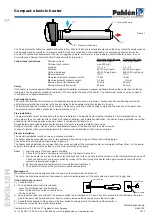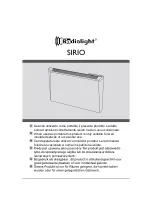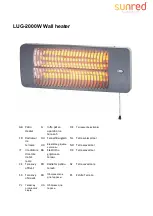
NOTE: L.P. (propane bottled) gas models have reverse (left
handed) thread on the manifold.
WARNING
DO NOT apply any thread sealant (pipe dope, teflon tape, etc.)
to these connections.
REMOVAL OF THE BURNER ASSEMBLY
For your safety the following procedure should be performed
by qualified service personnel or someone familiar with gas
appliances, as it involves disconnection of gas piping and leak
testing .
1. Turn gas control knob clockwise to “OFF” position. (Page
9 or 10).
2. Open outer and inner doors.
3. Disconnect the thermocouple, pilot tube, and manifold
tube at the thermostat (Figure 7). Note that the propane
(LPG) manifold has left hand thread rotation.
4. Remove the burner spreader by removing the nuts on top
of the spreader.
5. Pull the burner toward the front until the holding bracket
slides out of the slot in the bottom pan. If the burner is
dirty or clogged it cab be cleaned with soap and water.
REPLACING THE BURNER ASSEMBLY
1. Insert the burner assembly into the opening in the bottom
pan and slide toward the rear so that the burner holding
bracket slides into the slot in the bottom pan. Reinsert the
spreader on to the burner post and replace the two nuts.
2. The manifold tube will now line up to the thermostat
connection.
3. Reconnect the manifold tube and pilot tube. Do not cross
thread these fittings (Figure 7) . Note that the propane
(LPG) manifold has left hand thread rotation.
4. Reconnect the thermocouple.The thermocouple nut should
be started and turned all the way in by hand. An additional
one-quarter turn with a 3/8” open end wrench will be
sufficient to set the lockwasher (Figure 7).
CAUTION: OVERTIGHTENING MAY DAMAGE
THE THERMOCOUPLE OR THERMOS TAT.
5. Follow Lighting Instructions to relight water heater.
6. Check for gas leaks with soap and water solution (soap
suds) or liquid detergent. Bubble forming indicates a leak.
FIX ALL LEAKS IMMEDIATELY.
WARNING
DO NOT US E OPEN FLAME OR ANY KIND OF
S PARK TO CHECK FOR LEAKS .
12
130931 Rev April ʻ07
THERMOCOUPLE AND/OR
PILOT REPLACEMENT
1. Remove burner assembly. (See “REMOVAL OF BURNER
ASSEMBLY” section.)
2. Grasp the thermocouple line and moderately pull the ther-
mocouple from the pilot burner assembly. NOTE: If for
any reason the thermocouple will not disengage from the
pilot bracket assembly, replace the complete pilot
assembly, follow steps 4 and 5, otherwise go to next step.
3. Push replacement thermocouple through hole in pilot
bracket until it snaps in place. The end of a properly
installed thermocouple should extend approximately 1/4
inch past the tip of the pilot assembly (Go to step 6).
4. Remove No. 8-32 screw holding pilot assembly and pilot
shield (if provided) to main burner (Figure 8, Page 16).
5. Re-install replacement pilot assembly to main burner mak-
ing sure that pilot shield (if provided) is in the right
location. (Figure 8, Page 16).
6. Replace burner assembly (See “REPLACING THE
BURNER ASSEMBLY” section).
DRAINING AND FLUSHING
INTERIOR OF TANK
The water heater should be drained if being shut down during
freezing temperatures. Also periodic draining and cleaning of
sediment from the tank may be necessary.
1. “TURN OFF GAS TO APPLIANCE.” (Figure 6)
2. Close the cold water inlet valve to the heater (Figure 6).
3. Open a nearby hot water faucet.
4. Open the heater drain valve. (Figure 6).
WARNING
THIS WATER CAN BE HOT.
5. If the heater is going to be shut down and drained for an
extended period, the drain valve should be left open. Refer
to “Hydrogen Gas” warning, Page 8.
6. To start heater again, read paragraph “Operation” and
“LIGHTING INSTRUCTIONS”.
VENTING SYSTEM INSPECTION
Check the draft hood relief opening (Figure 6) using a match
flame after 15 minutes of operation. Pass the match flame
around the relief opening of the draft hood. A steady flame
drawn into the opening indicates proper draft. If the flame
flutters or is blown out this would indicate spillage and
corrective action must be made to the vent. (Figure 6).
At least every 3 months a visual inspection should be made of
the venting system. You should look for:
• Obstructions which cause improper venting.
• Damage or deterioration which could cause improper
venting or leakage of combustion products.
TAMPERING
Tampering with the thermostat, gas valve, pilot, burner, or
temperature and pressure relief valve is DANGEROUS and
voids all warranties. Only qualified personnel should service
these components.
C
A
U
T I
O
N
LOOSEN
THREAD
ROTATION
SEE NOTE BELOW
TIGHTEN
THREAD
ROTATION
SEE NOTE BELOW
Right Hand
Right Hand
thermocouple
pilot tube
manifold
Summary of Contents for 100-83 AS
Page 7: ...130931 Rev April 07 4...





































